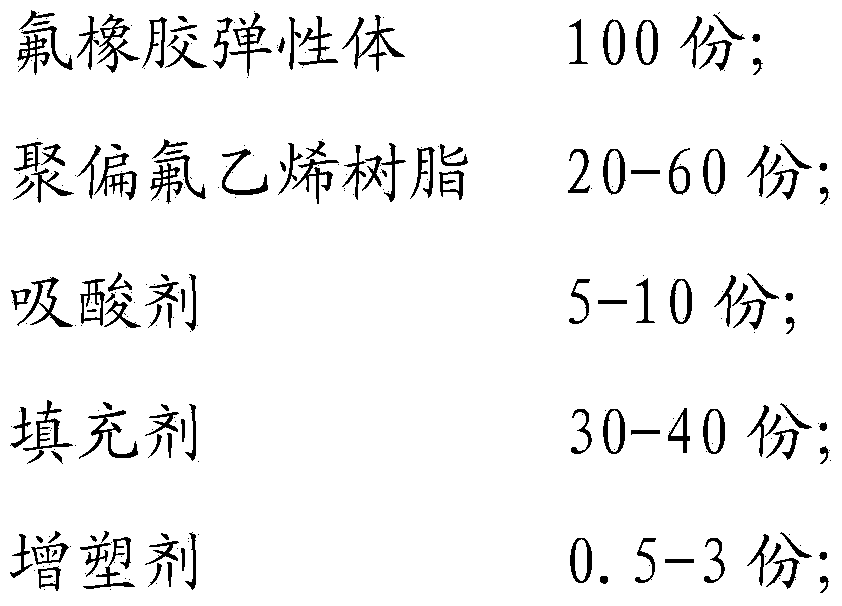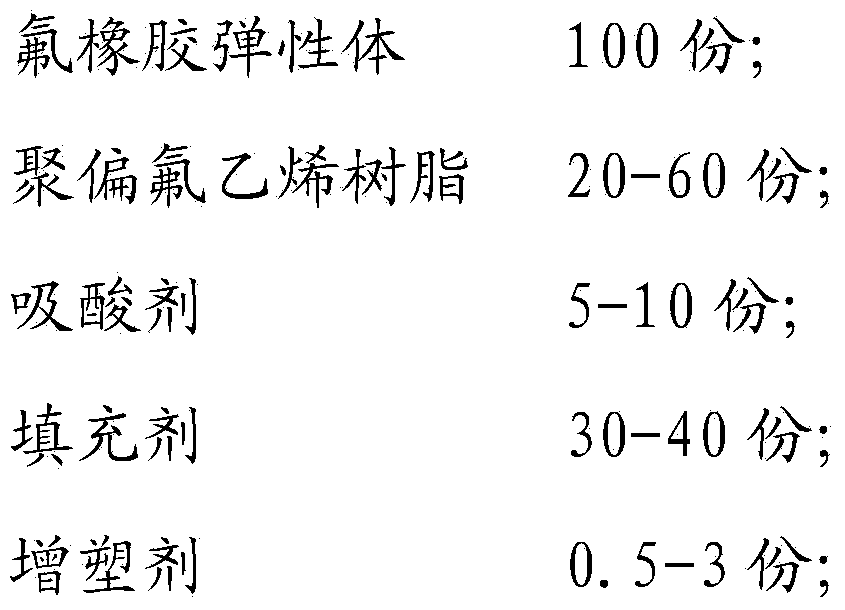Low-temperature-resistant fluororubber heat-shrinkable casing and manufacturing method thereof
A heat-shrinkable sleeve and fluororubber technology, applied in the field of low-temperature resistant fluororubber heat-shrinkable sleeve and its preparation, can solve the problems of poor heat-shrinkable low-temperature resistance and other problems, achieve good aging resistance, excellent low-temperature resistance, and improve The effect of low temperature performance
- Summary
- Abstract
- Description
- Claims
- Application Information
AI Technical Summary
Problems solved by technology
Method used
Image
Examples
preparation example Construction
[0033] The preparation method of the above-mentioned low-temperature resistant fluororubber heat-shrinkable sleeve comprises the following steps:
[0034] Step 1: According to parts by weight, weigh 100 parts of fluororubber elastomer, 20-60 parts of polyvinylidene fluoride resin, 5-10 parts of acid absorbing agent, 30-40 parts of filler, and 0.5-3 parts of plasticizer;
[0035] Step 2: After the above-mentioned components are mixed by an internal mixer and mixed and granulated by parallel twin-screws, they are extruded into pipes using a single-screw extruder;
[0036] Step 3: The pipe is cross-linked by cobalt-60 or electron accelerator 50-100KGy radiation;
[0037] Step 4: The radiation crosslinked tube is expanded 2-4 times at a temperature of 150-180°C.
preparation Embodiment 1
[0039] Take each component according to the parts by weight listed in the table below:
[0040]
[0041]
[0042] The above-mentioned materials are mixed by an internal mixer, mixed and granulated by parallel twin-screws, and extruded by a single-screw into pipes.
[0043] The tube is radiated and cross-linked by an electron accelerator of 90KGy, and the tube after radiation cross-linking expands twice at a temperature of 180°C to obtain a low-temperature resistant fluororubber heat-shrinkable sleeve, and its properties are as follows:
[0044] Flame retardancy: passed the VW-1 flame retardancy test;
[0045] Tensile strength: 11.2Mpa, elongation at break 388%;
[0046] The elongation at break after 250℃ / 168h high temperature aging is 356%;
[0047] 300℃±3℃ / 4h high temperature impact, no dripping, no cracking;
[0048] -40℃ / 4h low temperature test without cracking, no cracks;
preparation Embodiment 2
[0050] Take each component according to the parts by weight listed in the table below:
[0051]
[0052]
[0053] The above-mentioned materials are mixed by an internal mixer, mixed and granulated by parallel twin-screws, and extruded by a single-screw into pipes.
[0054] The tube is radiated and cross-linked by an electron accelerator of 90KGy, and the tube after radiation cross-linking expands twice at a temperature of 180°C to obtain a low-temperature resistant fluororubber heat-shrinkable sleeve, and its properties are as follows:
[0055] Flame retardancy: passed the VW-1 flame retardancy test;
[0056] Tensile strength: 16.9Mpa, elongation at break 321%;
[0057] The elongation at break after 250℃ / 168h high temperature aging is 293%;
[0058] 300℃±3℃ / 4h high temperature impact, no dripping, no cracking;
[0059] -40℃ / 4h low temperature test without cracking, no cracks;
PUM
| Property | Measurement | Unit |
|---|---|---|
| tensile strength | aaaaa | aaaaa |
| tensile strength | aaaaa | aaaaa |
| tensile strength | aaaaa | aaaaa |
Abstract
Description
Claims
Application Information
 Login to View More
Login to View More - R&D
- Intellectual Property
- Life Sciences
- Materials
- Tech Scout
- Unparalleled Data Quality
- Higher Quality Content
- 60% Fewer Hallucinations
Browse by: Latest US Patents, China's latest patents, Technical Efficacy Thesaurus, Application Domain, Technology Topic, Popular Technical Reports.
© 2025 PatSnap. All rights reserved.Legal|Privacy policy|Modern Slavery Act Transparency Statement|Sitemap|About US| Contact US: help@patsnap.com



